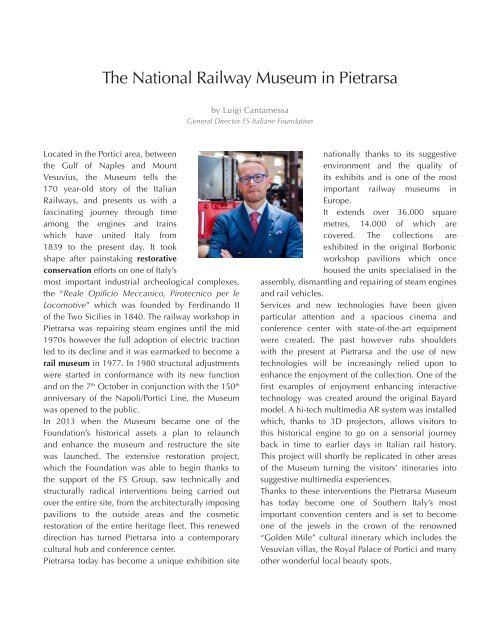SR_FW2019-20
You also want an ePaper? Increase the reach of your titles
YUMPU automatically turns print PDFs into web optimized ePapers that Google loves.
The National Railway Museum in Pietrarsa<br />
by Luigi Cantamessa<br />
General Director FS Italiane Foundation<br />
Located in the Portici area, between<br />
the Gulf of Naples and Mount<br />
Vesuvius, the Museum tells the<br />
170 year-old story of the Italian<br />
Railways, and presents us with a<br />
fascinating journey through time<br />
among the engines and trains<br />
which have united Italy from<br />
1839 to the present day. It took<br />
shape after painstaking restorative<br />
conservation efforts on one of Italy’s<br />
most important industrial archeological complexes,<br />
the “Reale Opificio Meccanico, Pirotecnico per le<br />
Locomotive” which was founded by Ferdinando II<br />
of the Two Sicilies in 1840. The railway workshop in<br />
Pietrarsa was repairing steam engines until the mid<br />
1970s however the full adoption of electric traction<br />
led to its decline and it was earmarked to become a<br />
rail museum in 1977. In 1980 structural adjustments<br />
were started in conformance with its new function<br />
and on the 7 th October in conjunction with the 150 th<br />
anniversary of the Napoli/Portici Line, the Museum<br />
was opened to the public.<br />
In <strong>20</strong>13 when the Museum became one of the<br />
Foundation’s historical assets a plan to relaunch<br />
and enhance the museum and restructure the site<br />
was launched. The extensive restoration project,<br />
which the Foundation was able to begin thanks to<br />
the support of the FS Group, saw technically and<br />
structurally radical interventions being carried out<br />
over the entire site, from the architecturally imposing<br />
pavilions to the outside areas and the cosmetic<br />
restoration of the entire heritage fleet. This renewed<br />
direction has turned Pietrarsa into a contemporary<br />
cultural hub and conference center.<br />
Pietrarsa today has become a unique exhibition site<br />
nationally thanks to its suggestive<br />
environment and the quality of<br />
its exhibits and is one of the most<br />
important railway museums in<br />
Europe.<br />
It extends over 36.000 square<br />
metres, 14.000 of which are<br />
covered. The collections are<br />
exhibited in the original Borbonic<br />
workshop pavilions which once<br />
housed the units specialised in the<br />
assembly, dismantling and repairing of steam engines<br />
and rail vehicles.<br />
Services and new technologies have been given<br />
particular attention and a spacious cinema and<br />
conference center with state-of-the-art equipment<br />
were created. The past however rubs shoulders<br />
with the present at Pietrarsa and the use of new<br />
technologies will be increasingly relied upon to<br />
enhance the enjoyment of the collection. One of the<br />
first examples of enjoyment enhancing interactive<br />
technology was created around the original Bayard<br />
model. A hi-tech multimedia AR system was installed<br />
which, thanks to 3D projectors, allows visitors to<br />
this historical engine to go on a sensorial journey<br />
back in time to earlier days in Italian rail history.<br />
This project will shortly be replicated in other areas<br />
of the Museum turning the visitors’ itineraries into<br />
suggestive multimedia experiences.<br />
Thanks to these interventions the Pietrarsa Museum<br />
has today become one of Southern Italy’s most<br />
important convention centers and is set to become<br />
one of the jewels in the crown of the renowned<br />
“Golden Mile” cultural itinerary which includes the<br />
Vesuvian villas, the Royal Palace of Portici and many<br />
other wonderful local beauty spots.
















